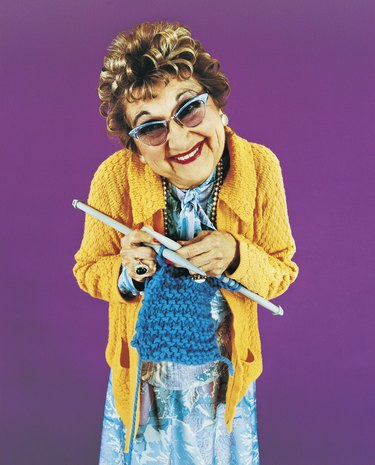Things You'll Need
Easy Way
Sweater
Water
2 bath towels
Yardstick
Straight pins
Hard Way
Calculator
Stitch gauge
Yarn
Knitting needles

A knitted sweater that's too small doesn't have to be a disappointment. If it's only slightly snug, it's easy to make it a size larger by stretching it slightly during blocking. Avoid a future problem by taking the recipient's body measurements and using a few techniques to enlarge the pattern. It may be as simple as using needles a size or two larger and a slightly heavier yarn than the pattern requires. Recalculating the stitch and row count to add width and length is more complicated but not difficult. A knitter with some experience and math skills will be able to increase the size with few problems.
The Easy Way
Step 1
Saturate the sweater with water and roll it in a towel. Press on it or step on it to squeeze excess water out of the sweater. It should be moist, not sopping wet. Use a second dry towel if necessary. Avoid wringing or twisting the sweater because this can damage the yarn fibers.
Video of the Day
Step 2
Place a dry towel on a hard flat surface. A table, cork board, mattress, foam mattress pad on the floor or a special blocking board will work. Lay the sweater flat on the blocking surface and nudge it into its approximate shape.
Step 3
Stretch the sweater slightly to the desired size, up to one full size. Use the yardstick for accurate dimensions. A tape measure can stretch and give inaccurate measurements. Avoid blocking the ribbing because this will cause it to lose some of its stretchiness.
Step 4
Pin the sweater to the towel with rustproof pins away from direct sun or heat. Allow to air dry.
The Hard Way
Step 1
Take accurate body measurements with the measuring tape before knitting a sweater. Knit a swatch to obtain the desired stitches per inch and rows per inch. Measure swatches with the stitch gauge. Using slightly larger needles or slightly thicker yarn may enlarge the sweater enough to fit. You may need to buy an extra skein or two of yarn because thicker yarns have fewer yards per ounce.
Step 2
Lengthen the sleeves and body by knitting a few more rows. An accurate rows-per-inch gauge is require for getting the right length. Purchase an extra ball or skein of yarn to make sure you have enough to complete the sweater.
Step 3
Use the calculator to multiply the individual body measurements by the stitches per inch and rows per inch. This is how many stitches need to be cast on and knitted. Armholes, sleeve tops and necklines may require more decreases to get rid of the extra stitches. Make sure to buy extra yarn so you don't run out in the middle of a sleeve.
Tip
Make a pattern by transferring the body measurements to paper and drawing an outline of the finished sweater. It helps visualize adjustments and their placement. It can be used as a reference when blocking the sweater after washing it.
When working a pattern stitch, adding one or two repeats of the design can add necessary width to the length and width.
Warning
Wet blocking can be used to adjust a sweater up to one size larger. Trying to exceed this limit will overstretch the knitted fabric and destroy its drape.
Wet blocking to increase a sweater's size works only with natural-fiber yarns.
Video of the Day
- KnitPicks: Blocking a Sweater Tutorial
- KnitPicks: Elizabeth's Percentage System
- Smart Knit-Crocheting: How to Make a Plus Size Sweater
- Bella Online: "Adjusting a Pattern"; Marjorie Colletta
- Knitting Daily: "The Basics of Blocking, Part One"; KD Sandi; July 2007
- "Sweater Design in Plain English;" Maggie Righetti; 1990
- "Knitting Without Tears;" Elizabeth Zimmerman; 1971